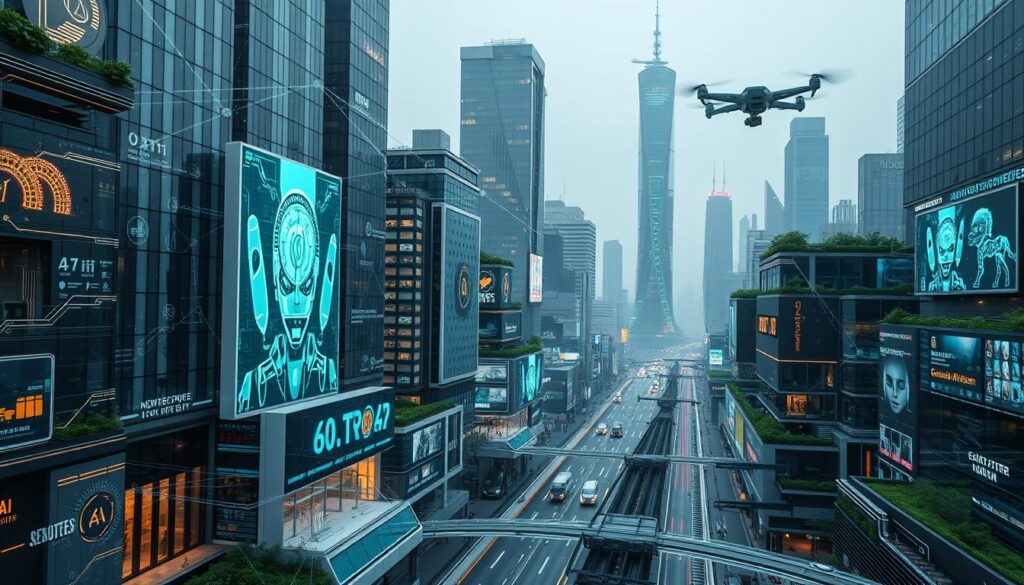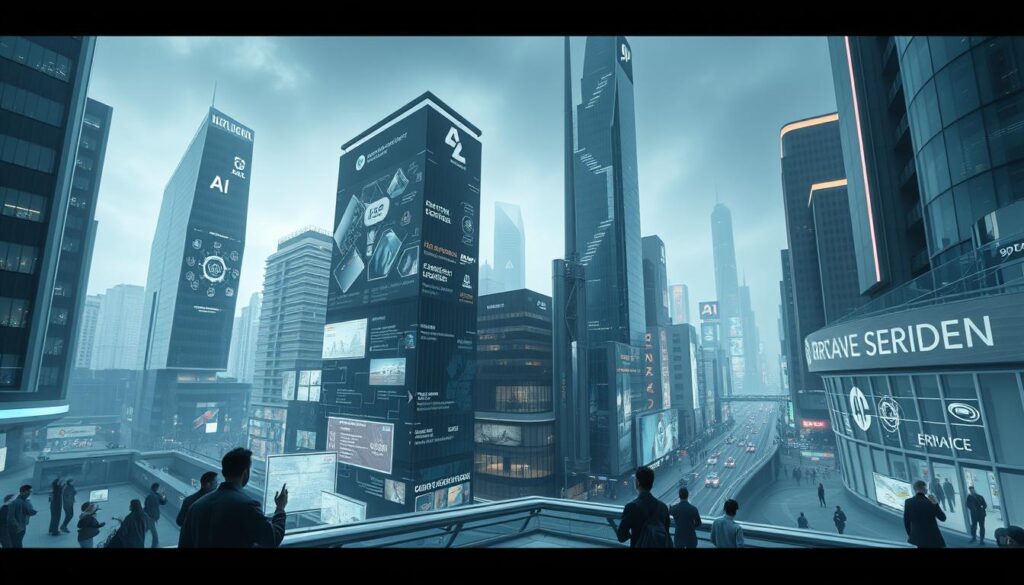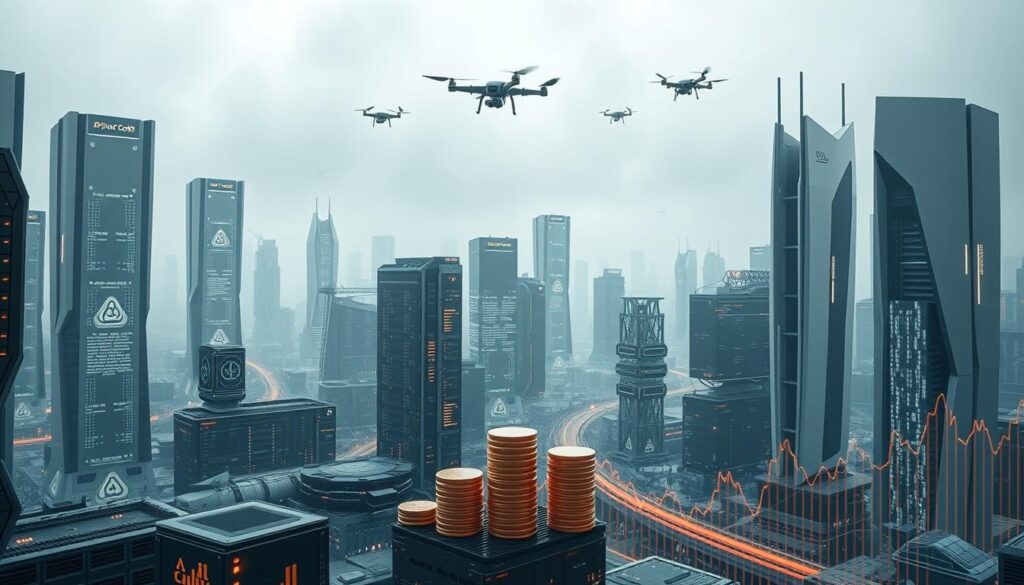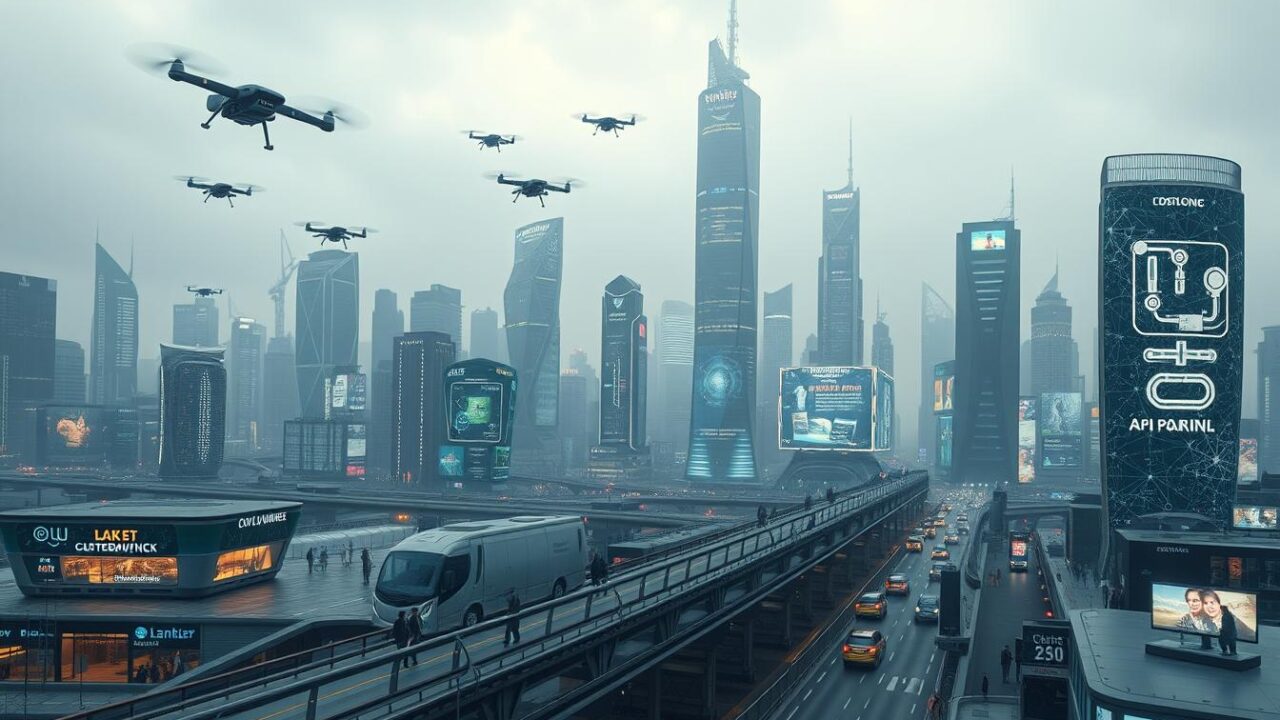Did you know only 10% of companies use AI a lot? Meanwhile, 51% are still trying it out. This is setting the stage for a big change in the ai wrapper economy future 2025. Artificial intelligence platforms are getting ready to change many industries.
As we get closer to 2025, the world of ai-powered services is changing fast. Big tech companies are spending billions on AI, pushing innovation and use. The use of advanced models like GPT-4 in products is speeding up, showing a move towards more intelligent automation.
More and more people are starting to understand how AI affects us. This is similar to how we became more aware of COVID-19. Because of this, we’re seeing a big increase in people wanting to work in AI fields. From 2023 to 2025, there’s been a 5-10x jump in students studying computer science, AI, and machine learning.
Key Takeaways
- Global AI spending forecast to reach $175 billion in 2024
- IT spending increased by 7.5% in 2024 due to AI investments
- AI expected to personalize 80% of customer interactions by 2025
- AI in manufacturing could contribute $1.4 trillion to global economy by 2025
- AI-driven healthcare analytics projected to save $100 billion annually from 2026
The Evolution of AI Wrapper Economy Future 2025

The AI wrapper economy is changing businesses fast. By 2025, cognitive computing and machine learning will change our world a lot. This marks a new era where AI fits smoothly into our products and services.
Understanding the AI Wrapper Concept
AI wrappers make old products smarter. They’re not just extras; they’re big changes. Companies are quickly adopting these new techs, with big tech leaders leading the way. The future of artificial intelligence is here, and it’s changing our lives in big ways.
Current Market Dynamics and Trends
The market is full of AI-powered ideas. AI is in everything from security to customer service. Algorithmic business models are now common, not rare. Here are some interesting facts:
- 75% of generative AI benefits focus on customer operations, marketing, and sales
- $1.7 billion invested in generative AI solutions in the past three years
- 56% of banks use AI for management
Key Economic Indicators and Predictions
The economic effect of AI is huge. Experts say AI will add $4.4 trillion to the global economy every year by 2025. AI education is growing a lot. AI is changing sales strategies and making new industries.
“AI isn’t just changing the game; it’s creating entirely new playing fields.”
As we get closer to 2025, the AI wrapper economy will bring a world where cognitive computing is as usual as smartphones. It’s a thrilling time for tech innovation and growth.
Impact of Generative AI on Business Transformation

Generative AI is changing the business world. It’s making decisions based on data and changing how things work in many areas. By 2025, 61% of big US companies plan to use AI to automate tasks, showing a big move towards intelligent automation.
This change is creating new jobs, like prompt engineers and AI ethics experts. Even though AI might replace some jobs, 72% of workers think it will make their work better. It’s not just about doing more work, but also making better decisions and starting new businesses based on AI.
AI is changing many industries:
- Retail: AI can help get 50% more leads and appointments.
- Healthcare: The AI market is expected to hit $45.2 billion by 2026.
- Finance: AI could save $447 billion by 2024.
Not all industries are using AI the same way. Wholesale, retail, and information sectors are leading, with over 57% of companies using AI. But traditional manufacturing is slower, with only 14% looking into AI.
“Generative AI has the power to increase productivity by up to 40%, transforming the way we work and create value.”
To get the most out of generative AI, companies need to look at their whole value chain. They should compare themselves to others and check their IT setup. This smart planning will help businesses use AI to innovate and stay ahead in the fast-changing digital world.
The Rising Costs of AI Infrastructure

Looking ahead to 2025, the cost of AI infrastructure is soaring. Tech giants are spending billions to grow their AI capabilities. For example, Microsoft plans to invest $80-110 billion in AI next year. This shows how vital AI platforms are for our digital future.
GPU Depreciation Challenges
Companies face a big challenge with the quick drop in GPU value. AI chip innovation is moving fast, making it hard for businesses to keep up. They’re trying to extend server life from five to six, but it’s getting tough.
Investment Requirements for AI Companies
The cost to compete in AI is huge. OpenAI, a top name in AI, got $6.6 billion in funding. Their monthly income jumped to $300 million in August 2023, a 1,700% rise. Yet, OpenAI still expects to lose $5 billion next year just on computing costs.
Cost Management Strategies
Companies are finding ways to handle these costs. Meta’s Llama 3 model is cheaper than GPT-4, used in Facebook, Instagram, and WhatsApp. This cost-saving method lets Meta use AI for billions of users, showing how to scale efficiently in AI.
As we head to 2025, managing costs and investments in AI will be key. It will help companies succeed in the changing world of AI and cognitive computing.
Workforce Transformation in the AI Era
The AI revolution is changing the job market. It’s creating new jobs and making old ones different. This change is making people want to learn more about AI and changing where we work.
Emerging Job Roles and Skills
Intelligent automation is making jobs change fast. By 2025, we’ll need 97 million experts in AI, machine learning, and data science. But, only 5% of U.S. high school graduates have the skills for these jobs.
Automation Impact Assessment
AI is making industries better and more efficient. Companies using AI have seen a 54% boost in productivity and lower costs. The supply chain industry, for example, saved 44% in 2019 thanks to AI.
Hybrid Work Model Evolution
AI is also changing how we work. With smart speakers in 45% of U.S. homes, work and home are mixing. This supports the growth of flexible, AI-based workspaces. Businesses are now focusing on improving customer experiences with AI, with 40% investing for this reason.
Did you know only 10% of companies use AI a lot? Meanwhile, 51% are still trying it out. This is setting the stage for a big change in the ai wrapper economy future 2025. Artificial intelligence platforms are getting ready to change many industries.
As we get closer to 2025, the world of ai-powered services is changing fast. Big tech companies are spending billions on AI, pushing innovation and use. The use of advanced models like GPT-4 in products is speeding up, showing a move towards more intelligent automation.
More and more people are starting to understand how AI affects us. This is similar to how we became more aware of COVID-19. Because of this, we’re seeing a big increase in people wanting to work in AI fields. From 2023 to 2025, there’s been a 5-10x jump in students studying computer science, AI, and machine learning.
Key Takeaways
- Global AI spending forecast to reach $175 billion in 2024
- IT spending increased by 7.5% in 2024 due to AI investments
- AI expected to personalize 80% of customer interactions by 2025
- AI in manufacturing could contribute $1.4 trillion to global economy by 2025
- AI-driven healthcare analytics projected to save $100 billion annually from 2026
The Evolution of AI Wrapper Economy Future 2025

The AI wrapper economy is changing businesses fast. By 2025, cognitive computing and machine learning will change our world a lot. This marks a new era where AI fits smoothly into our products and services.
Understanding the AI Wrapper Concept
AI wrappers make old products smarter. They’re not just extras; they’re big changes. Companies are quickly adopting these new techs, with big tech leaders leading the way. The future of artificial intelligence is here, and it’s changing our lives in big ways.
Current Market Dynamics and Trends
The market is full of AI-powered ideas. AI is in everything from security to customer service. Algorithmic business models are now common, not rare. Here are some interesting facts:
- 75% of generative AI benefits focus on customer operations, marketing, and sales
- $1.7 billion invested in generative AI solutions in the past three years
- 56% of banks use AI for management
Key Economic Indicators and Predictions
The economic effect of AI is huge. Experts say AI will add $4.4 trillion to the global economy every year by 2025. AI education is growing a lot. AI is changing sales strategies and making new industries.
“AI isn’t just changing the game; it’s creating entirely new playing fields.”
As we get closer to 2025, the AI wrapper economy will bring a world where cognitive computing is as usual as smartphones. It’s a thrilling time for tech innovation and growth.
Impact of Generative AI on Business Transformation

Generative AI is changing the business world. It’s making decisions based on data and changing how things work in many areas. By 2025, 61% of big US companies plan to use AI to automate tasks, showing a big move towards intelligent automation.
This change is creating new jobs, like prompt engineers and AI ethics experts. Even though AI might replace some jobs, 72% of workers think it will make their work better. It’s not just about doing more work, but also making better decisions and starting new businesses based on AI.
AI is changing many industries:
- Retail: AI can help get 50% more leads and appointments.
- Healthcare: The AI market is expected to hit $45.2 billion by 2026.
- Finance: AI could save $447 billion by 2024.
Not all industries are using AI the same way. Wholesale, retail, and information sectors are leading, with over 57% of companies using AI. But traditional manufacturing is slower, with only 14% looking into AI.
“Generative AI has the power to increase productivity by up to 40%, transforming the way we work and create value.”
To get the most out of generative AI, companies need to look at their whole value chain. They should compare themselves to others and check their IT setup. This smart planning will help businesses use AI to innovate and stay ahead in the fast-changing digital world.
The Rising Costs of AI Infrastructure

Looking ahead to 2025, the cost of AI infrastructure is soaring. Tech giants are spending billions to grow their AI capabilities. For example, Microsoft plans to invest $80-110 billion in AI next year. This shows how vital AI platforms are for our digital future.
GPU Depreciation Challenges
Companies face a big challenge with the quick drop in GPU value. AI chip innovation is moving fast, making it hard for businesses to keep up. They’re trying to extend server life from five to six, but it’s getting tough.
Investment Requirements for AI Companies
The cost to compete in AI is huge. OpenAI, a top name in AI, got $6.6 billion in funding. Their monthly income jumped to $300 million in August 2023, a 1,700% rise. Yet, OpenAI still expects to lose $5 billion next year just on computing costs.
Cost Management Strategies
Companies are finding ways to handle these costs. Meta’s Llama 3 model is cheaper than GPT-4, used in Facebook, Instagram, and WhatsApp. This cost-saving method lets Meta use AI for billions of users, showing how to scale efficiently in AI.
As we head to 2025, managing costs and investments in AI will be key. It will help companies succeed in the changing world of AI and cognitive computing.
Workforce Transformation in the AI Era
The AI revolution is changing the job market. It’s creating new jobs and making old ones different. This change is making people want to learn more about AI and changing where we work.
Emerging Job Roles and Skills
Intelligent automation is making jobs change fast. By 2025, we’ll need 97 million experts in AI, machine learning, and data science. But, only 5% of U.S. high school graduates have the skills for these jobs.
Automation Impact Assessment
AI is making industries better and more efficient. Companies using AI have seen a 54% boost in productivity and lower costs. The supply chain industry, for example, saved 44% in 2019 thanks to AI.
Hybrid Work Model Evolution
AI is also changing how we work. With smart speakers in 45% of U.S. homes, work and home are mixing. This supports the growth of flexible, AI-based workspaces. Businesses are now focusing on improving customer experiences with AI, with 40% investing for this reason.

